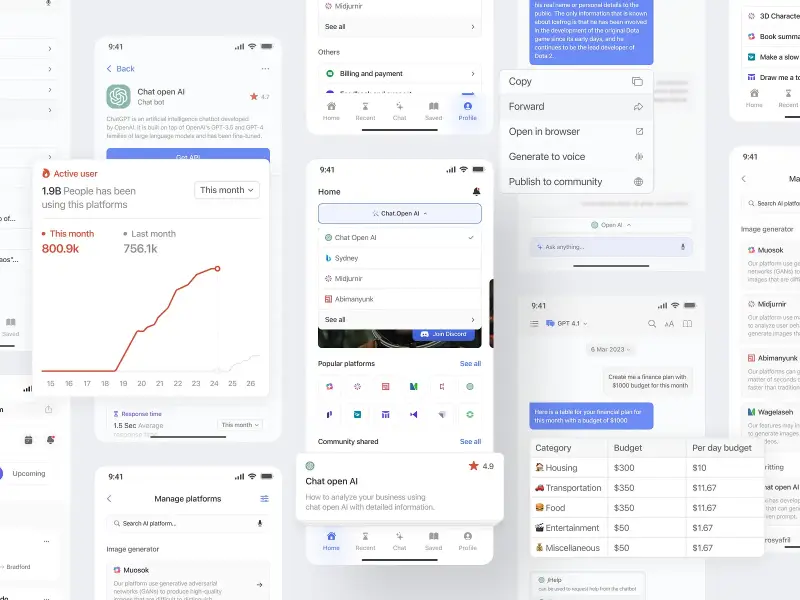15 Artificial Intelligence Challenges Every Business Faces
- Potter Le
- 0 Comments
AI is changing how businesses operate. It automates tasks, improves decision-making, and enhances customer experiences. But it also comes with challenges of AI in business that must be addressed for long-term success. Data quality issues. Ethical concerns. Complicated legal rules. Bias in algorithms. If companies don’t handle these problems, AI can create more harm than good.
Many businesses are already using AI. A recent PwC report predicts it could add $15.7 trillion to the global economy by 2030. Healthcare is adopting AI for faster diagnoses. Finance uses it to detect fraud. Retail relies on it for personalized shopping. Telecommunications improves customer service with AI-powered chatbots. Almost every industry is making the shift.
But AI isn’t just another tool you install and forget. It requires planning. Training. The right safeguards. Without them, mistakes happen. And those mistakes can be costly.
The first step is understanding the risks. Let’s explore the biggest artificial intelligence challenges businesses face—and the impact they can have on success.
15 Biggest Artificial Intelligence Challenges You Need to Prepare For
1. AI Ethical Issues
AI raises important ethical concerns. Privacy, fairness, and social impact are key issues. The challenges with AI include accountability in decision-making and ensuring fairness in automated processes. For example, AI-powered surveillance can track individuals without consent, creating serious privacy risks.
In sensitive areas like healthcare and criminal justice, ethical mistakes can have serious consequences. AI must be designed to make fair and unbiased decisions. Companies need clear guidelines to ensure AI respects human rights and operates transparently. Without ethical safeguards, AI can do more harm than good.
Learn More On:
2. Bias in AI
AI learns from data, but if that data is biased, AI can make unfair decisions. One of the biggest AI challenges is ensuring that automated systems do not reinforce discrimination in hiring, law enforcement, and loan approvals. For example, if an AI hiring tool is trained on biased data, it may favor certain candidates over others.
To reduce bias, companies must carefully select training data and test AI systems for fairness. Developers can use special techniques to adjust algorithms and make decisions more balanced. Regular audits help ensure AI treats everyone fairly and avoids reinforcing discrimination.
Artificial intelligence challenges
3. AI Integration
Adding AI to existing systems can be challenging. Among the key solutions to artificial intelligence problems is careful integration planning to ensure AI enhances business operations without disruption. Success requires teamwork between AI experts and industry professionals.
Challenges include making sure data is compatible, training employees, and adjusting workflows. Upskilling workers is essential so they can use AI effectively. Businesses should introduce AI gradually, provide support, and plan carefully to avoid disruptions. When done right, AI can improve efficiency and drive innovation.
4. Computing Power
AI needs a lot of computing power, especially for complex tasks like deep learning. High-performance hardware, such as GPUs and TPUs, is expensive and uses a lot of energy. Smaller businesses may struggle with these costs.
Cloud computing and distributed systems can help by providing access to powerful AI tools without high upfront costs. New technologies like neuromorphic and quantum computing may also help in the future. Finding a balance between performance and sustainability is key to making AI accessible to more businesses.
5. Data Privacy and Security
AI relies on large amounts of data, which creates privacy and security risks. One of the biggest challenges of AI in business is ensuring that sensitive information is protected from leaks and misuse. Strong security measures, like encryption and anonymization, can help keep data safe.
Techniques like differential privacy and federated learning allow AI to learn from data without exposing personal details. Clear policies and transparent data practices build trust with users. Protecting privacy is not just about following laws—it’s essential for maintaining confidence in AI systems.
Have a Project Idea in Mind?
Get in touch with experts for a free consultation. We’ll help you decide on next steps, explain how the development process is organized, and provide you with a free project estimate.
6. Legal Issues with AI
AI laws and regulations are still developing. Addressing challenges with AI requires businesses to stay ahead of legal concerns, including liability, intellectual property rights, and compliance standards. When AI makes a mistake or causes harm, it raises questions about who is responsible. If AI creates content, ownership rights can also become unclear.
Strict monitoring and clear policies are needed to reduce legal risks. Legal experts, policymakers, and technology specialists must work together to create rules that support innovation while protecting people’s rights. Without proper regulations, legal disputes over AI will continue to grow.
7. AI Transparency
AI transparency helps build trust and accountability. One of the most pressing AI challenges is ensuring users understand how AI makes decisions and processes data. This includes knowing what data it uses, how it processes information, and why it gives certain results.
Explainable AI (XAI) is one way to make AI more understandable. It helps users see the reasoning behind AI outputs. Clear documentation of data sources, training methods, and performance measures also improves transparency. When organizations openly share how AI works, people can trust it and use its results with confidence.
8. Limited Knowledge of AI
Many people do not fully understand AI. Misconceptions can lead to unrealistic expectations or misuse. Without proper knowledge, AI may be used irresponsibly or feared unnecessarily.
Education is key to solving this problem. Providing accessible resources and training can help people use AI more effectively. Schools, businesses, and community programs should work together to improve AI understanding. The more people know about AI, the better they can use it safely and responsibly.
Challenges of AI in business
9. Building Trust
People need to trust AI before they fully accept it. Trust comes from transparency, reliability, and accountability. Organizations must show how AI works, ensure it delivers consistent results, and take responsibility for any mistakes.
Engaging with users and addressing their concerns also helps build trust. Companies should collect feedback, fix biases, and prioritize ethical practices. When AI systems are open, fair, and dependable, people are more likely to use them with confidence.
10. Data Confidentiality
Protecting sensitive data is crucial in AI. Private information must stay secure and only be accessible to authorized users. Encryption, access controls, and secure storage methods help prevent leaks and misuse.
Following data privacy laws, such as GDPR and HIPAA, ensures AI systems handle data responsibly. Strong privacy protections build trust with users and show that AI can be used safely. Organizations must prioritize confidentiality to make AI systems reliable and ethical.
11. AI Arms Race
Countries are racing to develop advanced AI. Faster progress. Less oversight. Governments and militaries push for dominance. Autonomous weapons. AI-driven cyberwarfare. High risks. No international regulations.
Experts warn of dangers. More than a thousand tech leaders, including Steve Wozniak, have called for a pause in AI development. Their message: AI poses “profound risks to society and humanity.”
A future shaped by AI. It could bring progress. It could bring disaster. Without control, the AI arms race threatens global stability. The world must decide—innovation or safety?
12. Loss of Human Connection
As AI takes over more communication and social interactions, people may lose important human connections. Overreliance on AI-driven conversations can reduce empathy and weaken social skills. Maintaining a balance between technology and real human interaction is essential. Businesses and individuals should prioritize face-to-face communication where possible to preserve meaningful relationships.
13. Misinformation and Manipulation
AI-generated content, like deepfakes and fake news, can spread misinformation and manipulate public opinion. This threatens democracy and social trust. AI-powered bots can create false narratives, making it harder for people to distinguish truth from lies.
Efforts to detect and prevent AI-driven misinformation are critical. Fact-checking tools, AI detection software, and stricter regulations can help limit the spread of false information. Transparency in AI-generated content is necessary to protect public trust in the digital age.
14. Unintended Consequences
AI systems can behave in unpredictable ways. Their complexity and lack of human oversight may lead to unexpected outcomes, some of which can harm individuals, businesses, or society.
To reduce these risks, organizations must implement thorough testing and monitoring. AI models should be carefully validated before deployment. Continuous oversight can help catch errors and prevent AI from making harmful decisions.
15. Existential Risks
The possibility of artificial general intelligence (AGI) surpassing human intelligence raises serious concerns. If AGI is not aligned with human values, it could lead to unintended and potentially dangerous consequences.
To manage these risks, AI researchers must prioritize safety and ethical development. Collaboration, transparency, and strict guidelines are essential to ensure AGI benefits humanity rather than threatening it. The long-term impact of AGI must be carefully considered before advancing its development.
Learn More On:
How to Overcome AI Challenges
Addressing AI challenges requires a clear strategy. Organizations can take the following steps to ensure AI is ethical, fair, and reliable.
Challenges with AI
- Establish Ethical Guidelines
Companies should create ethical guidelines for AI development and use. A dedicated ethics committee can help enforce these rules and minimize ethical risks. Regular reviews ensure AI remains aligned with fairness, transparency, and human rights. - Reduce Bias in AI
AI systems should be regularly audited to detect and eliminate bias. Using diverse and representative datasets helps improve fairness. Continuous monitoring and algorithm adjustments ensure AI decisions remain objective and unbiased. - Improve Transparency and Explainability
AI should be understandable, especially in critical fields like healthcare and finance. Organizations should develop explainable AI models that clearly show how decisions are made. Transparent communication builds trust and helps users make informed choices. - Follow Legal and Regulatory Standards
Companies must stay updated on AI-related laws and regulations. Working with legal experts ensures compliance with intellectual property, liability, and data protection laws. A strong legal framework prevents legal risks and ensures responsible AI use. - Build Trust in AI
Trust comes from transparency and reliability. AI systems should undergo rigorous testing to ensure accurate and consistent results. Feedback mechanisms allow users to report concerns, helping organizations improve AI performance and fairness. - Set Realistic Expectations
Companies should clearly communicate what AI can and cannot do. Setting realistic goals prevents misunderstandings and ensures users know the system’s strengths and limitations. This helps avoid disappointment and misuse. - Protect Data and Ensure Privacy
Data security is crucial for AI adoption. Organizations should use encryption, access controls, and secure storage to protect sensitive information. Compliance with privacy laws, like GDPR and HIPAA, builds trust and prevents data breaches. - Plan for Malfunctions and Errors
AI is not perfect, so organizations must prepare for failures. Thorough testing and contingency plans help minimize disruptions. Having a response strategy ensures AI errors do not cause significant harm or operational issues.
Conclusion
AI is transforming industries, streamlining operations, and enhancing decision-making. But with its rapid growth come significant challenges—bias, misinformation, security risks, and ethical concerns. Ignoring these issues can lead to costly mistakes, legal troubles, and loss of trust.
To successfully integrate AI, businesses must address these challenges head-on. Thoughtful planning, ethical safeguards, and expert guidance are essential. That’s where TECHVIFY comes in.
Ready to harness AI without the risks? Our experts at TECHVIFY can help you navigate AI challenges, ensuring smooth, ethical, and effective implementation. Get a free consultation today and future-proof your AI strategy.
TECHVIFY – Global AI & Software Solution Company
From Startups to Industry Leaders: TECHVIFY prioritizes results, not just deliverables. Accelerate your time to market and see ROI early with high-performing teams, AI (including GenAI) Software Solutions, and ODC (Offshore Development Center) services.
- Email: [email protected]
- Phone: (+84)24.77762.666








